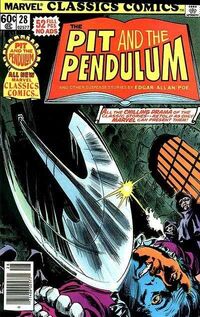How Does the Narrator Manage to Escape From the Pendulum?

Front cover of a comic book adaptation of "The Pit and the Pendulum' from Marvel comics with an issue date of January 1, 1977.
"The Pit and the Pendulum" is a short story by the American horror author Edgar Allan Poe. It was first printed in 1842 in the anthology The Gift: A Christmas and New Year's Present for 1843 published by Carey and Hart in Philadelphia.
The action takes places in the Spanish city of Toledo at an unspecified point in the past when the Spanish Inquisition was active. The unnamed narrator has been sentenced to death by the Inquisition but finds that he is not to die in a public execution. The Inquisitors originally intend for the narrator to act as his own executioner by tricking him into falling down a deep pit in his dark cell. After he manages to avoid that fate, he finds himself strapped to a table while a pendulum with a sharp metal edge descends from the ceiling very slowly, taking several days to get near to him.
There have been several film adaptations of "The Pit and the Pendulum", however, most of those adaptations have been very loose.
Plot

The narrator's trial. 1935 illustration by the British artist Arthur Rackham.
The unnamed narrator is sentenced to death for unspecified crimes by the Spanish Inquisition. After the sentence is passed on him, he begins to swoon and eventually loses consciousness. He later comes to believe that he has a faint recollection of being carried down to a deep dungron by a group of men, although he was unconscious at the time that would have happened.
It takes some time for the narrator to recover his senses. When he does, he finds himself in total darkness. He realizes that he is not yet dead, in spite of the sentence which has been passed against him, but must instead be in the notorious Toledo prison about which he has heard strange stories. He finds that his clothes have been taken away and that he is wearing a robe of coarse cloth. Bread and water are provided once a day, always while the narrator is asleep. The stone floor of the cell is slippery and slimy. Curious to find out how large his cell is, the narrator tears a strip of cloth from his robe to use as a marker. He counts the steps that he takes as he feels his way along the wall until he comes back to the piece of cloth. However, he finds that he is too weak to complete the circuit of his cell without needing to sleep.
After having determined the size and shape of his cell, the narrator decides to move away from its walls and walk across the floor. He trips over the torn hem of his robe and finds that he has narrowly avoided falling down a deep pit. He realizes that the Inquisitors intended him to die by falling down the pit in the dark. Supposing that there are several other such pits in his large cell. He keeps close to its walls afterwards. The officers of the Inquisition take notice and the narrator's water is drugged.
When he awakens from the deep sleep caused by the drugged water, the narrator finds himself strapped to a wooden table. He is only able to move his head and move his left arm from the elbow with difficulty. There is no water but there is food placed where he can reach it. The spicy food is intended to make the narrator even thirstier and he has to compete for it with a vast number of rats who have emerged from the pit. At first, he is able to shoo the rats away with a wave of his hand but the gesture soon has no effect on them and they climb on to his body whenever he is still. There is now enough light for the narrator to clearly see his cell. He notices that it is much smaller than he had imagined it to be and there is only one pit in the floor. The cell is square, not the strange shape the narrator had imagined it to be by feeling its bumpy walls. The walls, which he had imagined were stone, are really made of metal and are painted with images of demons.

The pendulum gets nearer to the narrator as the rats bite away his ropes. 1905 illustration by the British artist Byam Shaw.
On the ceiling, the narrator notices a painting of Old Father Time carrying a pendulum instead of a scythe. The narrator gradually realizes that the pendulum is not painted but real and is slowly descending, coming increasingly close to him. He later realizes that the edge of the pendulum is made of sharp metal. This method of execution is purposefully slow. It takes several days for the pendulum to get close enough for the narrator to smell its metal. He then realizes that his death will be further prolonged because the pendulum will need to cut the thick cloth of his robe before it can slices into his flesh above his heart.
When the pendulum is almost upon him, the narrator comes up with an escape plan. He lies perfectly still, which causes vast numbers of rats to climb up upon him. The rats bite into the straps which are holding him down, allowing him to get off the table.
The pendulum moves up to the ceiling again. The narrator realizes that he is being constantly watched and that for every form of execution that he escapes, another will be prepared. The cell's metal walls begin to heat up. The narrator begins to think of plunging into the pit to cool down but resists the thought. The hot walls then begin to close in, forcing him ever nearer to the edge of the pit.
Just as he is about to fall into the pit, someone helps the narrator up. The person who has come to his aid is a French general. Toledo has been invaded and the Inquisition have lost their power.
Adaptations

Poster for the 1961 film The Pit and the Pendulum.
Films based on "The Pit and the Pendulum" have been produced in France (1909), Czechoslovakia (1983) and the United States (1913, 1961, 1991, 2006 and 2009).
The best known movie adaptation continues to be the 1961 American film, set in 16th century Spain, directed by Roger Corman and starring Vincent Price and Barbara Steele.The plot, in which an Englishman comes to Spain to investigate the sudden death of his sister, has very little to do with Poe's story. The deadly pendulum only appears in the final ten minutes of the movie, in which the Englishman is tortured by his mad brother-in-law, who believs himself to be his own ancestor, one of the officials of the Spanish Inquisition. A novel by Lee Sheridan based on the film's screenplay was published in paperback in 1961.
See also
- Sound file of public domain audiobook of "The Pit and the Pendulum" from LibriVox
- "The Adventure of the Engineer's Thumb"
External links
- Text of Edgar allan Poe's "The Pit and the Pendulum" on Wikisource.
- "The Pit and the Pendulum" on the SparkNotes website.
How Does the Narrator Manage to Escape From the Pendulum?
Source: https://literature.fandom.com/wiki/The_Pit_and_the_Pendulum